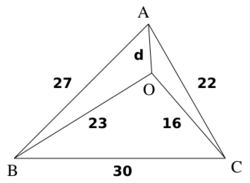Almost integer

In recreational mathematics, an almost integer (or near-integer) is any number that is not an integer but is very close to one. Almost integers may be considered interesting when they arise in some context in which they are unexpected.
Almost integers relating to the golden ratio and Fibonacci numbers
Some examples of almost integers are high powers of the golden ratio[math]\displaystyle{ \phi=\frac{1+\sqrt5}{2}\approx 1.618 }[/math], for example:
- [math]\displaystyle{ \begin{align} \phi^{17} & =\frac{3571+1597\sqrt5}{2}\approx 3571.00028 \\[6pt] \phi^{18} & =2889+1292\sqrt5 \approx 5777.999827 \\[6pt] \phi^{19} & =\frac{9349+4181\sqrt5}{2}\approx 9349.000107 \end{align} }[/math]
The fact that these powers approach integers is non-coincidental, because the golden ratio is a Pisot–Vijayaraghavan number.
The ratios of Fibonacci or Lucas numbers can also make almost integers, for instance:
- [math]\displaystyle{ \operatorname{Fib}(360)/\operatorname{Fib}(216) \approx 1242282009792667284144565908481.999999999999999999999999999999195 }[/math]
- [math]\displaystyle{ \operatorname{Lucas}(361)/\operatorname{Lucas}(216) \approx 2010054515457065378082322433761.000000000000000000000000000000497 }[/math]
The above examples can be generalized by the following sequences, which generate near-integers approaching Lucas numbers with increasing precision:
- [math]\displaystyle{ a(n) = \operatorname{Fib}(45\times2^n)/\operatorname{Fib}(27\times2^n) \approx \operatorname{Lucas}(18\times2^n) }[/math]
- [math]\displaystyle{ a(n) = \operatorname{Lucas}(45\times2^n+1)/\operatorname{Lucas}(27\times2^n) \approx \operatorname{Lucas}(18\times2^n+1) }[/math]
As n increases, the number of consecutive nines or zeros beginning at the tenths place of a(n) approaches infinity.
Almost integers relating to e and π
Other occurrences of non-coincidental near-integers involve the three largest Heegner numbers:
- [math]\displaystyle{ e^{\pi\sqrt{43}}\approx 884736743.999777466 }[/math]
- [math]\displaystyle{ e^{\pi\sqrt{67}}\approx 147197952743.999998662454 }[/math]
- [math]\displaystyle{ e^{\pi\sqrt{163}}\approx 262537412640768743.99999999999925007 }[/math]
where the non-coincidence can be better appreciated when expressed in the common simple form:[2]
- [math]\displaystyle{ e^{\pi\sqrt{43}}=12^3(9^2-1)^3+744-(2.225\ldots)\times 10^{-4} }[/math]
- [math]\displaystyle{ e^{\pi\sqrt{67}}=12^3(21^2-1)^3+744-(1.337\ldots)\times 10^{-6} }[/math]
- [math]\displaystyle{ e^{\pi\sqrt{163}}=12^3(231^2-1)^3+744-(7.499\ldots)\times 10^{-13} }[/math]
where
- [math]\displaystyle{ 21=3\times7, \quad 231=3\times7\times11, \quad 744=24\times 31 }[/math]
and the reason for the squares is due to certain Eisenstein series. The constant [math]\displaystyle{ e^{\pi\sqrt{163}} }[/math] is sometimes referred to as Ramanujan's constant.
Almost integers that involve the mathematical constants π and e have often puzzled mathematicians. An example is: [math]\displaystyle{ e^\pi-\pi=19.999099979189\ldots }[/math] The explanation for this seemingly remarkable coincidence was given by A. Doman in September 2023, and is a result of a sum related to Jacobi theta functions as follows: [math]\displaystyle{ \sum_{k=1}^{\infty}\left( 8\pi k^2 -2 \right) e^{-\pi k^2} = 1. }[/math] The first term dominates since the sum of the terms for [math]\displaystyle{ k\geq 2 }[/math] total [math]\displaystyle{ \sim 0.0003436. }[/math] The sum can therefore be truncated to [math]\displaystyle{ \left( 8\pi -2\right) e^{-\pi}\approx 1, }[/math] where solving for [math]\displaystyle{ e^{\pi} }[/math] gives [math]\displaystyle{ e^{\pi} \approx 8\pi -2. }[/math] Rewriting the approximation for [math]\displaystyle{ e^{\pi} }[/math] and using the approximation for [math]\displaystyle{ 7\pi \approx 22 }[/math] gives [math]\displaystyle{ e^{\pi} \approx \pi + 7\pi - 2 \approx \pi + 22-2 = \pi+20. }[/math] Thus, rearranging terms gives [math]\displaystyle{ e^{\pi} - \pi \approx 20. }[/math] Ironically, the crude approximation for [math]\displaystyle{ 7\pi }[/math] yields an additional order of magnitude of precision. [1]
Another example involving these constants is: [math]\displaystyle{ e+\pi+e\pi+e^\pi+\pi^e=59.9994590558\ldots }[/math]
See also
References
External links
 |

